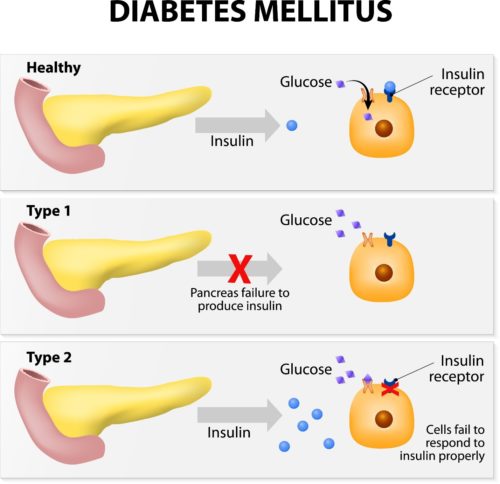
Constant sugar consumption is one of the primary causes of type 2 diabetes (we’ll explain why below). This is the kind of diabetes that you are NOT born with but rather develops over time, usually due to a combination of lifestyle issues (eating too much sugar and grains, being too sedentary, overeating, and being overweight) and a propensity to be more susceptible to diabetes from the genes you inherited from your parents.
If type 2 diabetes runs in your family, you need to be especially concerned about keeping your sugar intake low. Eating less sugar doesn’t mean you won’t develop diabetes but it gives you a fighting chance not too, and at minimum, it will delay the onset of pre-diabetes and full-blown diabetes. Plus, if you do develop type 2 diabetes, it will likely be less severe than it would have if you constantly ate too much sugar. And the good thing is, that type 2 diabetes is completely reversible with a low-carb or ketogenic diet – for example with a keto-vegan diet.
To understand why sugar causes diabetes, or causes it to appear earlier than it should if you are genetically predisposed to it, you have to understand a bit of biology about the pancreas and hormones. So, it’s time to dust out the cobwebs in your mind and do a little mini refresher course of some of the biology you probably learned in high school.

Right behind your stomach (toward your back) is an organ about the size of your hand. This organ is called the pancreas. Most of the pancreas seems to be designed to crank out digestive enzymes. While it is possible for something to go wrong in this part of the pancreas, it usually does not. In fact, even in type 1 diabetics, the part of the pancreas responsible for producing digestive enzymes usually works fine.
The smallest part of the pancreas actually has the most powerful role to place. This part is called the “islets of Langerhans” and consists of clusters of highly specialized cells that produce powerful hormones that control your food metabolism. The unusual name comes from the German scientist who discovered them.
There are actually several types of specialized cells in the islets of Langerhans but the most famous are the beta cells. These cells are the ones that produce one of the most well-known hormones in the body, insulin. In a healthy non-diabetic person, beta cells respond to the glucose in the bloodstream and produce just the right amount of insulin needed to help the glucose cross over the cell membranes of all the various cells in the body. The glucose needs to enter the inside of the cells so it can be used to fuel the cell and all its functions like DNA repair and sending chemical messages to other cells. Or, if you get too much glucose – which is dreadfully common nowadays – your body converts it to fat. It’s sugar that makes you fat, not the fat you eat!
When people eat too much sugar (or grains or starches), this makes their beta cells work overtime because so much extra insulin is needed to deal with all the extra sugar. When you’re a child and even into your twenties, this is usually not a problem because you have a young vital body with young vital beta cells. However, with each passing year, not only your cells become “deaf” to the flood of insulin that tries to help the glucose get into them, but it also becomes increasingly difficult for your beta cells to keep up with the high demand for insulin if you just keep eating too much sugar all the time. This is one of the reasons it’s never too late to stop eating so much sugar! If you have inherited bad genes that makes you more susceptible to developing type 2 diabetes, your beta cells may not last as long under these same conditions as they would in a person without this genetic predisposition to type 2 diabetes.
In people with pre-diabetes, beta cells start to fail, i.e. they start to dysfunction and even die. Another issue is that the other specialized cells in the islets of Langerhans that produce hormones involved in controlling gastric emptying start to dysfunction as well. By the way, gastric emptying is how fast your food leaves your stomach and how fast the glucose from the breakdown of the food gets released into your bloodstream after a meal. To make matters even worse, another type of specialized cell in the islets of Langerhans produces ghrelin, the hunger hormone, which can make you crave sugar even more as you develop type 2 diabetes! The specialized cells that produce hormones other than insulin in the islets of Langerhans can also be damaged by eating too much sugar all the time.

So, let’s now simplify this a bit and talk about what it all means in terms of real everyday life.
If you have family members with type 2 diabetes, then you need to be especially protective of your beta cells and other specialized cells located in the islets of Langerhans within your pancreas. The most important thing you can do to protect these specialized cells is to lay off the sugar and make absolutely certain you never get addicted to sugar. If you already have an addiction to sugar, pull out all the stops and break your addiction right now! Your lifespan could depend on it!
Another precaution you can take is to not overeat as this will contribute to making the specialized hormone producing cells in your islets of Langerhans cells work too hard as well.
If you don’t have any family history of diabetes, constantly eating too much sugar – whether on a vegan diet or not — can STILL make you develop type 2 diabetes by wearing out your beta cells that have to keep pumping out all that extra insulin to compensate and in wearing out other specialized cells in the islets of Langerhans. However, it may take more time to develop than in someone who has family members with type 2 diabetes.

Leave a Reply
You must be logged in to post a comment.